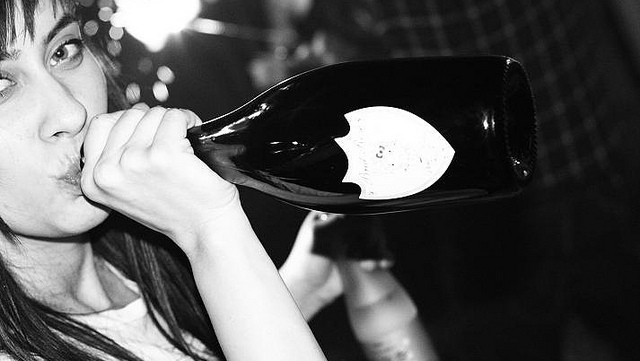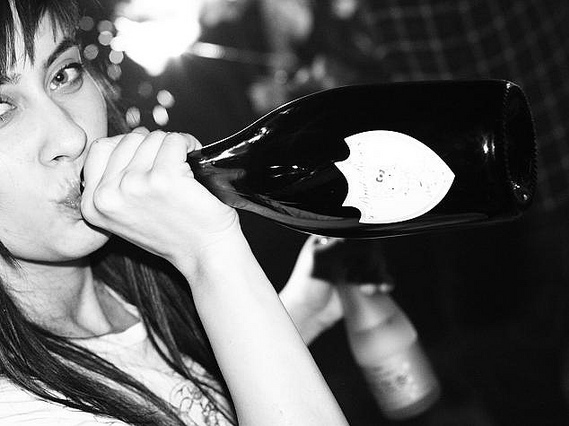
In her recent book ”Drink: The Intimate Relationship Between Women and Alcohol,” award-winning writer Ann Dowsett Johnson tells of her struggle with alcoholism:
“I became an award-winning magazine writer, got married and had a son. I created my own opportunities. My husband and I separated when our son was 5, but we continued to share all daily duties, and all of the pleasures, too. Always, there were trade-offs. I didn’t write my column as often as I should have, in those years when my son was at home. Most nights I got home late: Too often, I was trundling in with groceries after 7 o’clock, cooking fast for a hungry boy. And somewhere along the line, I would surprise myself by drinking too much, using alcohol as a shock absorber.”
For Johnson, her divorce, her position as vice president of McGill University, and later the loneliness she felt after her son left for college, all caused her to turn to alcohol to numb her emotions. “It was then that my evening glass of wine turned into two or three, which eventually became three or four,” Johnson says. “On this, I am not alone.”
Johnson is correct. Women — particularly well-educated women — struggling with alcoholism is a growing epidemic.
But what is the reason for this? Which women are most at risk and what is being done to combat the rising problem of women battling alcohol abuse?
Women battling alcoholism on the rise
As a report from ABC News recently pointed out, recent surveys have demonstrated that 47 percent of White women were regular drinkers in 2002, up from 37 percent a decade earlier.
That rate grew from 21 percent to 30 percent amongst Black women, and among Hispanic women, it was up from 24 percent to 32 percent.
“Our latest epidemiological surveys show that more than 5 percent of women in the United States have alcohol use disorders,” Dr. Deidra Roach, a health science administrator in the National Institute on Alcohol Abuse and Alcoholism division of treatment and recovery research, told ABC.
“The gap overall between women and men who have alcohol problems seems to be narrowing,” Roach said. “Typically, we know from our population surveys that the people who consume the most are highly educated women with high incomes.”
As author Gabrielle Glaser told the Wall Street Journal:
“A few summers ago, I stuffed my car full of the last flattened cardboard boxes from a cross-country move and headed to the recycling depot of my suburban New Jersey town. I pulled up behind a queue of slender women at the wheels of shiny SUVs. Their eyes concealed by giant sunglasses, they hopped from their seats to their open trunks and, one by one, reached for the bags that are the totems of upper-middle-class life: silver ones from Nordstrom, plain ones from Whole Foods. Out poured wine bottles, clanking into the rusted recycling truck. In Portland, Ore., where I lived for six years, I would watch most Sunday nights as a neighbor deposited two giant Merlot bottles in my recycling bin. Her house was a block away, and she had her own bin—but apparently mine seemed like a more discreet place to stash her empties. In New York’s Westchester County, where I had lived previously, women would pass around a flask at dreary school functions. Alcohol and motherhood were intertwined, so much so that after I had my third daughter in the anxious autumn after 9/11, I received bottle after bottle of wine as baby gifts.”
How liquor advertising targets women
Indeed, the idea of women drinking — and moreover, of women using drinking as a coping mechanism for life’s challenges — has become somewhat of a new normal.
From Facebook memes to t-shirts (or a onesie for a baby like the one pictured here reading “Mommy needs wine because I whine”) to TV shows like the “Real Housewives” series — where women are rarely seen without a glass of some alcoholic beverage in their hands — it seems media have embraced this image and are perpetuating it. Meanwhile, alcohol companies are marketing directly to women with products such as “MommyJuice.” The wine company’s website tells prospective women customers: “Being a mom is a constant juggling act. Whether it’s playdates and homework, diapers and burp cloths, or finding that perfect balance between work and home, Moms everywhere deserve a break. So tuck your kids into bed, sit down and have a glass of MommyJuice — because you deserve it!”
As the Wall Street Journal reports:
“The growing sales of wine to women can be traced to some clever marketing decisions in the 1960s by California’s vintners. Wineries had all but perished during Prohibition, and the beverage was considered the drink of poor immigrants and Skid Row drunks. Americans, accustomed to more straightforward spirits and beer, were slow to warm to wine’s complexities.”
The same article also talks about how former first lady Jacqueline Kennedy made drinking wine glamorous in the 1950s, and how in California, “where laws allowed wine to be sold in supermarkets, Robert Mondavi’s marketers hired middle-age housewives to stand at in-store tasting booths.”
“The saleswomen offered shoppers sips from bottles that would pair perfectly with what they had planned for dinner. The friendly older women helped turn the younger women into confident consumers. Women’s magazines offered tips on how to order, serve and drink the stuff; McCall’s magazine, in 1977, featured wine as essential to an ‘Anti-Stress Diet.’ Meanwhile, women in California were beginning to make wine, too, experimenting with tastes and textures.”
Drinking more devastating for women
In her book, Johnson cites the work of Sharon Wilsnack, an American alcohol researcher at the University of North Dakota. Wilsnack claims that a “global epidemic” in women’s drinking is underway.
In 2011, Katherine Keyes of Columbia University looked at 31 international studies of birth-cohort and gender differences in alcohol consumption and mortality. Keyes discovered that those born after the Second World War are more likely to binge drink and develop alcohol-use disorders than their older counterparts.
“Those born between 1978 and 1983 are the weekend warriors, drinking to black out,” Keyes says. “In that age group, there is a reduction in male drinking, and a sharp increase for women.”
Research also shows that women in their 40s and 50s have a very high risk for both heavy drinking and weekly drinking. “We’re not saying, ‘Put down the sherry and go back to the kitchen,’” says Keyes. “But when we see these steep increases, you wonder if we are going to see a larger burden of disease for women.”
Research also indicates that the reason women turn to drinking is to stave off negative feelings, while men tend to drink in order to be social. However, drinking affects women differently, and perhaps more adversely than men.
As women typically have more body fat — and thus less body water — than men, their bodies tend not to dilute alcohol as efficiently. Women also have lower levels of an enzyme that helps the body break down alcohol. Hormone fluctuations make women even more vulnerable when estrogen levels rise. And moreover, alcohol-related liver and brain damage appears more quickly in women who drink heavily than in their male counterparts.
“The list goes on,” Johnston writes. “Women’s chemistry means they become dependent on alcohol much faster than men. Other consequences — including cognitive deficits and liver disease — all occur in women, with significantly shorter exposure to alcohol. Women who consume four or more alcoholic beverages a day quadruple their risk of dying from heart disease. Heavy drinkers of both genders run the risk of a fatal hemorrhagic stroke, but the odds are five times higher for women.”
Turning points
For Johnson, her turning point came when she had a root canal that went awry, which required her to take pain medicine that forced her to stop drinking for three weeks. Her then-20-year-old son Nicholas made her a Mother’s Day card titled “Happy Mother.” The card depicted her sitting at a typewriter. “The whites of her eyes are white,” he wrote. “She is drinking Perrier, not wine.”
Johnson says the card, and the realization that she had not been the person — or the mother — she wanted to be due to her drinking “… ended my romance with the glass. For three years I carried it everywhere, tucking it into my diary or my daybook: the truth writ large from a man I loved, one I had let down and who was brave enough to tell me how he felt.”
As Gallup polls have found that the more educated and well-off a woman is, the more likely she is to drink, some have been quick to say that the feminist movement is to blame for the rising epidemic.
But I tend to think it has more to do with marketing tactics aimed at women, as well as drinking becoming socially acceptable, if not a norm, within Western culture. It’s time to challenge these influences, so that women can live happy, healthy and fulfilling lives.
The gender gap in underage drinking has closed, as today young girls are drinking more than underage boys. Young females are more likely to have drunk alcohol than males, as 70.9 percent of female high school students have ever drunk compared to 70.6 percent of male high school students, the Center for Alcohol Marketing and Youth at Johns Hopkins University has found.
The study also found that girls between ages 12 and 20 saw 68 percent more beer advertising and 30 percent more distilled spirits advertising in magazines than women of legal age on a per capita basis.
Some researchers, like Minnesota-based Mark Willenbring, a psychiatrist and the former director of treatment research at the National Institute of Alcohol Abuse and Alcoholism, told the WSJ that a combination of specialized treatment and new drugs could help to ameliorate disorders, in a similar manner that Prozac was used to treat depression.
Willenbring also believes that primary-care doctors should be trained to administer anti-relapse drugs and counseling to those who seek help with alcohol abuse.
The views expressed in this article are the author’s own and do not necessarily reflect Mint Press News’ editorial policy.


